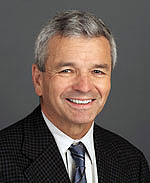May 2, 2012 - By Tracie White

Charles Prober
Dramatic changes are needed in medical student education, including a substantial reduction in the number of traditional lectures, according to a perspective piece published May 3 in the New England Journal of Medicine by two Stanford University professors.
Medical education has changed little in the past 100 years despite dramatic changes in the world of medicine, the explosion in biomedical information and the ever-growing complexity of the health-care system. The traditional lecture format persists even as class attendance is plummeting and as many complain that the current system is failing to produce compassionate, well-trained physicians.
“Students are being taught roughly the same way they were taught when the Wright brothers were tinkering at Kitty Hawk,” write co-authors Charles Prober, MD, senior associate dean for medical education at the Stanford School of Medicine, and Chip Heath, PhD, professor of organizational behavior at the Stanford Graduate School of Business. (Heath and his brother, Dan, also authored a bestselling book, Made to Stick: Why Some Ideas Survive and Others Die.) In contemplating medical education reform, Prober reached out to Heath because a critical goal of any educational effort is to optimize the retention of lessons — to increase their “stickiness.”
In their perspective, titled “Lecture halls without lectures,” Prober and Heath propose a new approach to teaching to make better use of the fixed amount of educational time available to train doctors.
“That’s the vision that we want to chase: education that wrings more value out of the unyielding asset of time,” the authors write. “Why would anyone waste precious class time on a lecture?”
Prober also has been working closely with Salman “Sal” Khan, the Silicon Valley-based online learning pioneer whose nonprofit effort, Khan Academy, is widely credited, in the words of Bill Gates, for having “turned the classroom — and the world of education — on its head.” Prober and Heath’s perspective piece proposes a Khan Academy-styled “flipped-classroom” model of teaching. Lecture content is packaged in 10- to 15-minute videos that are watched by the students at their own pace and as often as necessary to learn the material. Class time is then freed up for more interactive education, with greater emphasis on patients’ clinical stories as a way to increase the relevance of the necessary scientific and medical knowledge.
“Teachers would be able to actually teach, rather than merely make speeches,” the authors write.
The core biochemistry class at Stanford medical school was redesigned this year to follow this model. The instructors replaced the lecture-based format with short online videos made available to students. “Class time was used for interactive discussions of clinical vignettes that highlighted the biochemical bases of various diseases,” the article said. “Student reviews of the course improved substantially from the previous year, and class attendance increased from 30 to 80 percent, even though class attendance was optional.”
Prober said early experimentation with this model has been extremely positive.
“It’s my strong belief that this is an effective model for delivering factual material,” Prober said. “It could facilitate students’ education by allowing them to learn the core content in a user-friendly way. Students struggling with the information can watch the mini-videos over and over again. Low-stakes quizzes ensure the students have grasped the knowledge.”
Students then come together in the “flipped classroom” where they can use the facts they’ve learned in “engaged, active learning,” Prober explained. The in-class lessons would use alternatives to lectures to more successfully engage students, fuel their curiosity and increase information retention. “Patients’ stories are what makes the acquisition of medical knowledge compelling,” the authors write. “They serve as the scaffolding on which facts and concepts can be organized and reinforced. ...Yet conversations with medical students about the first-year medical curriculum reveal that about half of lectures proceed without even the briefest patient example.
“A single case could serve as the lead-in to multiple medical school topics that otherwise might seem dry and routine,” the authors write. “It’s a method used often in pop culture to draw in viewers in such television shows as ‘House’ and ‘ER.’”
The authors imagine instead a new world of medical education, one where students are engaged and fueled by a curiosity that makes learning stick.
They write: “Imagine a first-year medical student who learns critical biochemistry pathways by watching short videos as many times as necessary in the comfort of his or her personal learning space. Knowledge acquisition is verified by repeated low-stakes quizzes. Then, in class, the student participates in a discussion that includes a child with a metabolic disease, his or her parents, the treating clinician, and the biochemistry professor. The relevant biochemistry — so dry on the page of a textbook — comes to life.
“The lesson sticks.”
About Stanford Medicine
Stanford Medicine is an integrated academic health system comprising the Stanford School of Medicine and adult and pediatric health care delivery systems. Together, they harness the full potential of biomedicine through collaborative research, education and clinical care for patients. For more information, please visit med.stanford.edu.